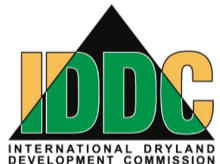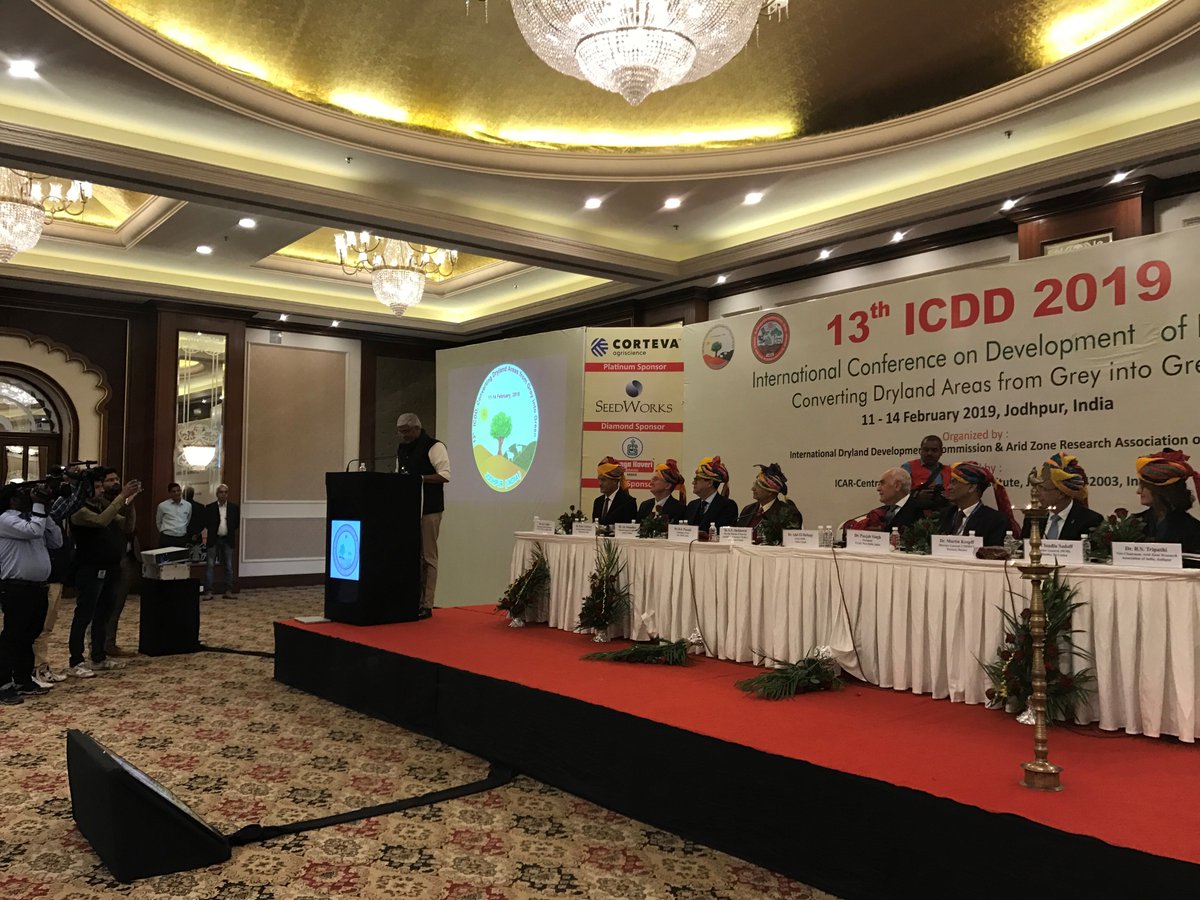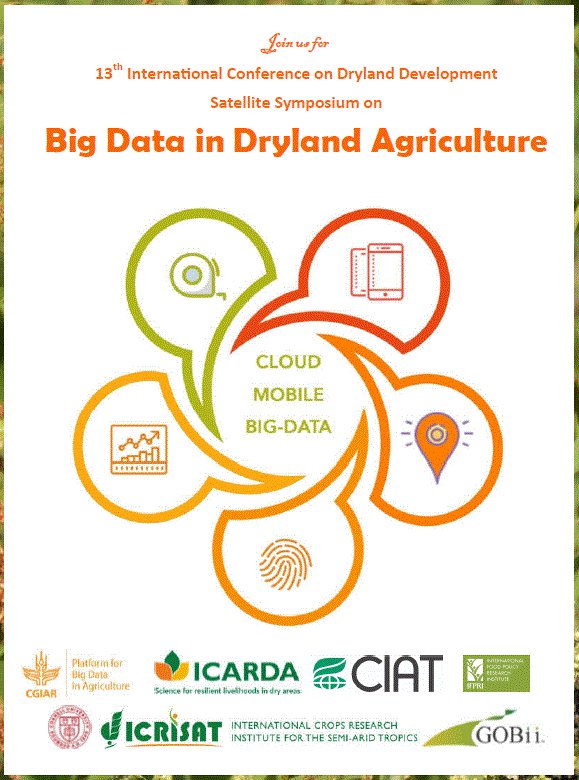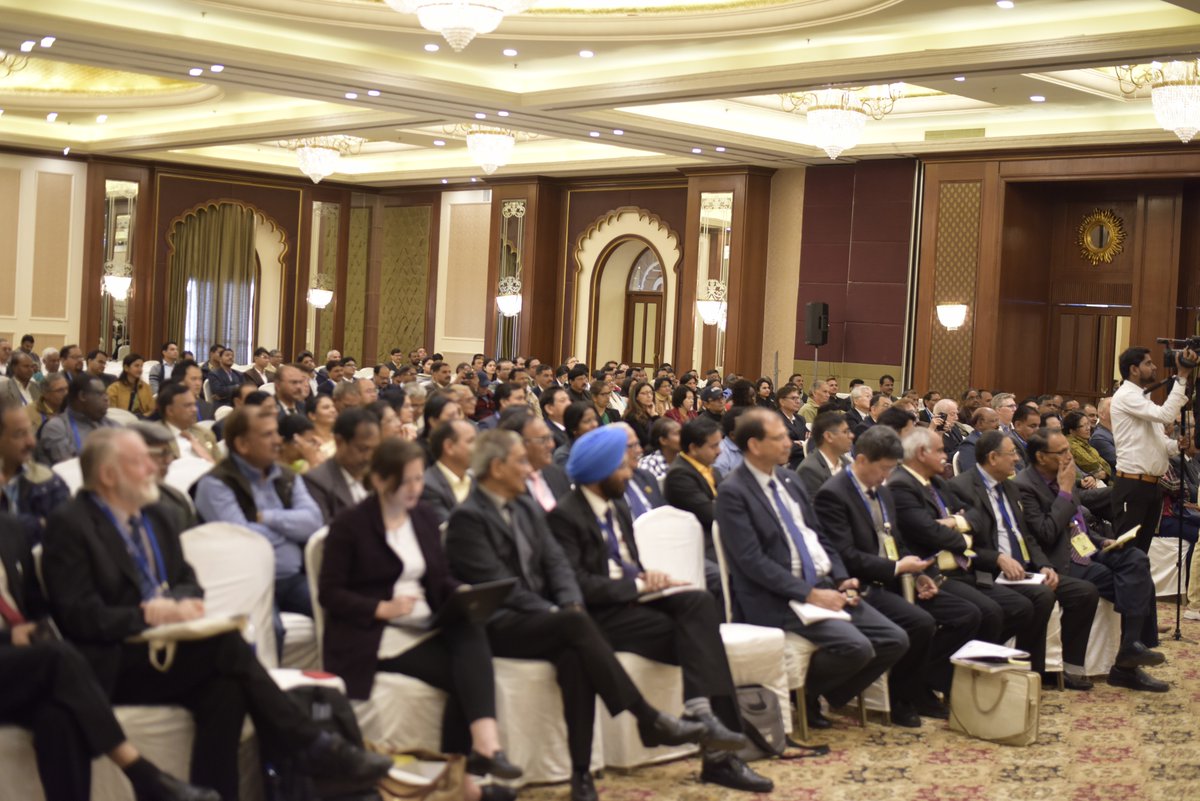 11-14 February 2019. Jodhpur, India. The 13th International Conference on Dryland Development, with the theme “Converting Dryland Areas from Grey into Green”, is organized by IDDC (International Dryland Development Commission) and the Arid Zone Research Association of India (AZRAI) and hosted by the ICAR-Central Arid Zone Research Institute (CAZRI).
11-14 February 2019. Jodhpur, India. The 13th International Conference on Dryland Development, with the theme “Converting Dryland Areas from Grey into Green”, is organized by IDDC (International Dryland Development Commission) and the Arid Zone Research Association of India (AZRAI) and hosted by the ICAR-Central Arid Zone Research Institute (CAZRI).
 Drylands cover about 41% of earth’s land area and are home to ~38% of world population. A majority (90%) of the people of this ecosystem live in developing countries. With fragile natural resource base, achieving food security in drylands has been a great challenge. With the threat of climate change looming large and additional threat of massive out-migration, the livelihoods of more than 2 billion people who live in these areas, will be further at risk.
Drylands cover about 41% of earth’s land area and are home to ~38% of world population. A majority (90%) of the people of this ecosystem live in developing countries. With fragile natural resource base, achieving food security in drylands has been a great challenge. With the threat of climate change looming large and additional threat of massive out-migration, the livelihoods of more than 2 billion people who live in these areas, will be further at risk.
 The efforts of research and development community and policymakers dealing with dry areas and aiming at sustainable management of natural resources have to be boosted in order to optimize adaptive mechanism and risk aversion elements for the dryland communities.
The efforts of research and development community and policymakers dealing with dry areas and aiming at sustainable management of natural resources have to be boosted in order to optimize adaptive mechanism and risk aversion elements for the dryland communities.
 Fast sharing of knowledge and capacity building of all the stakeholders in dryland will have to be an essential element of these efforts. Institutional reforms at the ecosystem level to bridge the divide in the governance of different natural resources including water coupled with the global commitment for greater coordination in legal, policy and management issues shall pave the path for sustainable livelihood security in drylands and in converting dryland areas from grey to green.
Fast sharing of knowledge and capacity building of all the stakeholders in dryland will have to be an essential element of these efforts. Institutional reforms at the ecosystem level to bridge the divide in the governance of different natural resources including water coupled with the global commitment for greater coordination in legal, policy and management issues shall pave the path for sustainable livelihood security in drylands and in converting dryland areas from grey to green.




“Evidence shows that the dry areas and the MENA region specifically, for example, is heading towards a much warmer climate scenario over the next 50 years than initially anticipated.”
“As highlighted by the IPCC Special report on impacts of global warming in October 2018, climate change impact can be avoided by limiting global warming to 1.5 degrees Celsius compared to 2 degrees, or more. Also noted in this report is that by limiting global warming, people and ecosystems will have more room to adapt and remain below relevant risk thresholds. To undertake this critical adaptation, appropriate local intervention schemes can be applied and instead interrupt negative effects of climate change.”
“Published last month, the EAT-Lancet report on Food in the Anthropocene cites the need for environmental systems and processes to be maintained for sustainable food production. Global food systems transformation is needed urgently to ensure long-term sustainability both in terms of food production and to reduce the threat to local ecosystems. Mr. Aly Abousabaa (see picture), Director General of ICARDA“
12 February: TU – ICARDA Satellite Symposium : Crop Improvement for Sustainable Production
The marginal region is the place where one or more of the factors necessary for plant production do not reach the level of the requirement. To achieve the goal to produce the necessary amount of crops under the changing climate, we need to extensively improve the crop varieties combining knowledge and technologies of molecular biology, genetics, physiology, informatics, modeling, and others. This satellite symposium is aimed to exchange the research activities among researchers studying cereals, pulses, and root symbiotic microbes, and know the present status and prospects to develop marginal regions for sustainable crop production.

 12 February: Big Data in Dryland Agriculture
12 February: Big Data in Dryland Agriculture
13 February: Dryland Agrobiodiversity for Adaptation to Climate Change
Amongst the total 34 global hotspots, 9 are in the dry lands and about 0.5% of the plant species are endemic to the region. In terms of agriculture, plant species endemic to the drylands make up 30% of the plants under cultivation today, including many ancestors and crop wild relatives (CWRs). However, exact status of species in the dry lands remains unknown, as no comprehensive assessment has been collated. The objectives of this mini-symposium are:
 |
| Gajendra Singh Shekhawat (Indian Minister of State for Agriculture and Farmers Welfare) addressed the Inaugural Session |
14 February: Arid Agro-ecosystem: Challenges and Opportunities
The Arid ecosystem covers around 17% of the world’s land area and are inhabited by about 6% population which manifests insurmountable challenges due to inhospitable climate, vast livestock and human population surviving on limited and fragile natural resources.
Source: PAEPARD FEED
by secretary
by secretary
by secretary
by secretary
by secretary
by secretary
by secretary
by secretary
by secretary
by secretary
by secretary
by secretary
by secretary
by secretary
by secretary
by secretary
by secretary
by secretary
by secretary
by secretary
by secretary
by secretary
by secretary
by secretary
by secretary
by secretary
by secretary
by secretary
by secretary
by secretary
by secretary
by secretary
by secretary
by secretary
by secretary
by secretary
by secretary
by secretary
by secretary
by secretary
by secretary
by secretary
by secretary
by secretary
by secretary
by secretary
by secretary
by secretary
by secretary
by secretary
by secretary
by secretary
by secretary
by secretary
by secretary
by secretary
by secretary
by secretary
by secretary
by secretary
by secretary
by secretary
by secretary
by secretary
by secretary
by secretary
by secretary
by secretary
by secretary
by secretary
by secretary
by secretary
by secretary
by secretary
by secretary
by secretary
by secretary
by secretary
by secretary
by secretary
by secretary
by secretary
by secretary
by secretary
by secretary
by secretary
by secretary
by secretary
by secretary
by secretary
by secretary
by secretary
by secretary
by secretary
by secretary
by secretary
by secretary
by secretary
by secretary
by secretary
by secretary
by secretary
by secretary
by secretary
by secretary
by secretary
by secretary
by secretary
by secretary
by secretary
by secretary
by secretary
by secretary
by secretary
by secretary
by secretary
by secretary
by secretary
by secretary
by secretary
by secretary
by secretary
by secretary
by secretary
by secretary
by secretary
by secretary
by secretary
by secretary
by secretary
by secretary
by secretary
by secretary
by secretary
by secretary
by secretary
by secretary
by secretary
by secretary
by secretary
by secretary
by secretary
by secretary
by secretary
by secretary
by secretary
by secretary
by secretary
by secretary
by secretary
by secretary
by secretary
by secretary
by secretary
by secretary
by secretary
by secretary
by secretary
by secretary
by secretary
by secretary
by secretary
by secretary
by secretary
by secretary
by secretary
by secretary
by secretary
by secretary
by secretary
by secretary
by secretary
by secretary
by secretary
by secretary
by secretary
by secretary
by secretary
by secretary
by secretary
by secretary
by secretary
by secretary
by secretary
by secretary
by secretary
by secretary
by secretary
by secretary
by secretary
by secretary
by secretary
by secretary
by secretary
by secretary
by secretary
by secretary
by secretary
by secretary
by secretary
by secretary
by secretary
by secretary
by secretary
by secretary
by secretary
by secretary
by secretary
by secretary
by secretary
by secretary
by secretary
by secretary
by secretary
by secretary
by secretary
by secretary
by secretary
by secretary
by secretary
by secretary
by secretary
by secretary
by secretary
by secretary
by secretary
by secretary
by secretary
by secretary
by secretary
by secretary
by secretary
by secretary
by secretary
by secretary
by secretary
by secretary
by secretary
by secretary
by secretary
by secretary
by secretary
by secretary
by secretary
by secretary
by secretary
by secretary
by secretary
by secretary
by secretary
by secretary
by secretary
by secretary
by secretary
by secretary
by secretary
by secretary
by secretary
by secretary
by secretary
by secretary
by secretary
by secretary
by secretary
by secretary
by secretary
by secretary
by secretary
by secretary
by secretary
by secretary
by secretary
by secretary
by secretary
by secretary
by secretary
by secretary
by secretary
by secretary
by secretary
by secretary
by secretary
by secretary
by secretary
by secretary
by secretary
by secretary
by secretary
by secretary
by secretary
by secretary
by secretary
by secretary
by secretary
by secretary
by secretary
by secretary
by secretary
by secretary
by secretary
by secretary
by secretary
by secretary
by secretary
by secretary
by secretary
by secretary
by secretary
by secretary
by secretary
by secretary
by secretary
by secretary
by secretary
by secretary
by secretary
by secretary
by secretary
by secretary
by secretary
by secretary
by secretary
by secretary
by secretary
by secretary
by secretary
by secretary
by secretary
by secretary
by secretary
by secretary
by secretary
by secretary
by secretary
by secretary
by secretary
by secretary
by secretary
by secretary
by secretary
by secretary
by secretary
by secretary
by secretary
by secretary
by secretary
by secretary
by secretary
by secretary
by secretary
by secretary
by secretary
by secretary
by secretary
by secretary
by secretary
by secretary
by secretary
by secretary
by secretary
by secretary
by secretary
by secretary
by secretary
by secretary
by secretary
by secretary
by secretary
by secretary
by secretary
by secretary
by secretary
by secretary
by secretary
by secretary
by secretary
by secretary
by secretary
by secretary
by secretary
by secretary
by secretary
by secretary
by secretary
by secretary
by secretary
by secretary
by secretary
by secretary
by secretary
by secretary
by secretary
by secretary
by secretary
by secretary
by secretary
by secretary
by secretary
by secretary
by secretary
by secretary
by secretary
by secretary
by secretary
by secretary
by secretary
by secretary
by secretary
by secretary
by secretary
by secretary
by secretary
by secretary
by secretary
by secretary
by secretary
by secretary
by secretary
by secretary
by secretary
by secretary
by secretary
by secretary
by secretary
by secretary
by secretary
by secretary
by secretary
by secretary
by secretary
by secretary
by secretary
by secretary
by secretary
by secretary
by secretary
by secretary
by secretary
by secretary
by secretary
by secretary
by secretary
by secretary
by secretary
by secretary
by secretary
by secretary
by secretary
by secretary
by secretary
by secretary
by secretary
by secretary
by secretary
by secretary
by secretary
by secretary
by secretary
by secretary
by secretary
by secretary
by secretary
by secretary
by secretary
by secretary
by secretary
by secretary
by secretary
by secretary
by secretary
by secretary
by secretary
by secretary
by secretary
by secretary
by secretary
by secretary
by secretary
by secretary
by secretary
by secretary
by secretary
by secretary
by secretary
by secretary
by secretary
by secretary
by secretary
by secretary
by secretary
by secretary
by secretary
by secretary
by secretary
by secretary
by secretary
by secretary
by secretary
by secretary
by secretary
by secretary
by secretary
by secretary
by secretary
by secretary
by secretary
by secretary
by secretary
by secretary
by secretary
by secretary
by secretary
by secretary
by secretary
by secretary
by secretary
by secretary
by secretary
by secretary
by secretary
by secretary
by secretary
by secretary
by secretary
by secretary
by secretary
by secretary
by secretary
by secretary
by secretary
by secretary
by secretary
by secretary
by secretary
by secretary
by secretary
by secretary
by secretary
by secretary
by secretary
by secretary
by secretary
by secretary
by secretary
by secretary
by secretary
by secretary
by secretary
by secretary
by secretary
by secretary
by secretary
by secretary
by secretary
by secretary
by secretary
by secretary
by secretary
by secretary
by secretary
by secretary
by secretary
by secretary
by secretary
by secretary
by secretary
by secretary
by secretary
by secretary
by secretary
by secretary
by secretary
by secretary
by secretary
by secretary
by secretary
by secretary
by secretary
by secretary
by secretary
by secretary
by secretary
by secretary
by secretary
by secretary
by secretary
by secretary
by secretary
by secretary
by secretary
by secretary
by secretary
by secretary
by secretary
by secretary
by secretary
by secretary
by secretary
by secretary
by secretary
by secretary
by secretary
by secretary
by secretary
by secretary
by secretary
by secretary
by secretary
by secretary
by secretary
by secretary
by secretary
by secretary
by secretary
by secretary
by secretary
by secretary
by secretary
by secretary
by secretary
by secretary
by secretary
by secretary
by secretary
by secretary
by secretary
by secretary
by secretary
by secretary
by secretary
by secretary
by secretary
by secretary
by secretary
by secretary
by secretary
by secretary
by secretary
by secretary
by secretary
by secretary
by secretary
by secretary
by secretary
by secretary
by secretary
by secretary
by secretary
by secretary
by secretary
by secretary
by secretary
by secretary
by secretary
by secretary
by secretary
by secretary
by secretary
by secretary
by secretary
by secretary
by secretary
by secretary
by secretary
by secretary
by secretary
by secretary
by secretary
by secretary
by secretary
by secretary
by secretary
by secretary
by secretary
by secretary
by secretary
by secretary
by secretary
by secretary
by secretary
by admin
by admin
by admin
by admin
by admin
by admin
by admin
by admin
by admin



